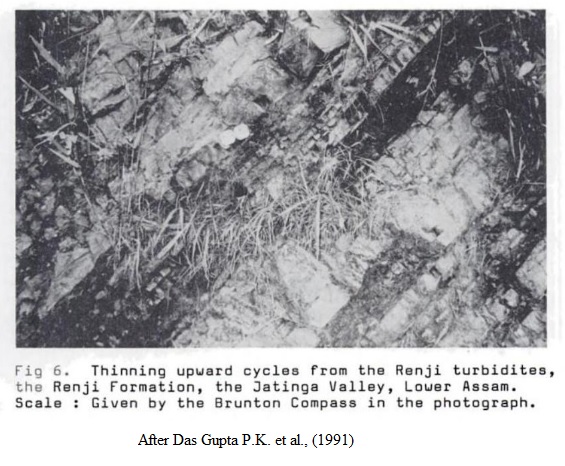Renji Fm
Type Locality and Naming
Upper formation of Barail Gr. Type section is in the Renji Hills north of Badarpur. [Original Publication: Evans P. 1932: Tertiary succession in Assam, Trans. Min. Geol. Inst. India, vol.27, pp.155.]. Reference well: Badarpur well -2, 635 m thickness in the upthrust block in Badarpur 2.
Synonyms: The hard, ferruginous, usually massive sandstones overlying Jenams were grouped under Renji Stage by Evans (1932). Ranga Rao (1983) referred these rocks as Renji Formation.
[Figure 1: Formation stratotypes of North East Basins (modified after Pandey and Dave, 1998)
Lithology and Thickness
Sandstone. Type section: Renji Formation is an arenaceous unit with thin shale and sandy shale interbeds. The sandstones near the top are moderately coarse, ferruginous, thick to massive bedded with minor sandy shale interbeds. Reference section: In Badarpur Well 2 it consists of sandstones with thin shale and sandy shale interbeds. The sandstones are grey to dark grey, medium to fine grained, coarse towards top, well rounded, moderately hard, ferruginous with occasional coal streaks. The shales are bluish grey to dark grey, hard and compact, occasionally thinly laminated. 700 m thickness which increases to 950 m in the Jenam River Section. In the Schuppen Belt the maximum thickness of 850 m has been reported, (Singh et al., 1986).
[Figure 2: Thinning upward cycles from the Renji turbidites (after Dasgupta P.K. et al., 1991)]
Relationships and Distribution
Lower contact
Gradational contact with the Jenam Fm.
Upper contact
Unconformable contact with the Middle Bhuban Fm.
Regional extent
Khasi & Jaintia Hills, Naga Schuppen Belt, Tripura Cachar, SE Bangladesh: Renji Formation is well exposed in the Barail Range, Schuppen Belt (southwest of Nichuguard), southeastern part of Shillong Plateau and eastern Manipur area. In subsurface, it is penetrated in Badarpur and Hilara structures of Cachar. Further south in Mizoram area, Renji Formation has been penetrated in one well i.e., Rengte 2. Renji Formation does not show any marked lithological variation in different tectonic blocks. In the areas south of Haflong-Disang thrust, the carbonaceous shales are not persistent. Thin coal bands are also present in the lower part. In Schuppen Belt, it comprises of thick-bedded sandstones alternating with thinly bedded grey sandy siltstones and shales. The sandstone is bioturbated and shows high angle tabular and planar cross-bedding.
GeoJSON
Fossils
Palynological assemblages comprising of Arecipites communis, Couperipollis rarispinous, Margocolporites sp. etc. are recorded from the outcrops along Silcher-Halflong road section.
Age
Depositional setting
Deltaic.
Additional Information

